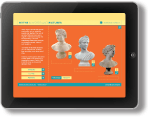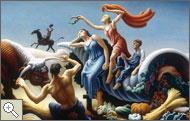


In a fun game, students compare sculptures of three Greek immortals. The sculptures include subtle symbols of the subjects' stories. So who is who? Play Symbols in Art: Who's Who?.
|
 |
Image Information
Psyche, Hiram Powers, 1848. Smithsonian American Art Museum
Diana, Hiram Powers, 1853. Smithsonian American Art Museum
Clytie, Hiram Powers, ca. 1867. Smithsonian American Art Museum
Moon image. National Air and Space Museum
Butterfly image. National Museum of Natural History
Sunflower image. National Museum of Natural History
Drinking cup depicting Achelous and Hercules. Greek, ca. 560–550 B.C. Museum of Fine Arts, Boston
Running Atalanta, Paul Manship, 1958. Smithsonian American Art Museum
Atalanta, Paul Manship, 1921. Smithsonian American Art Museum
Ceres, Roman, n.d. Smithsonian American Art Museum
Harvest, Sondra Freckelton, 1978. Smithsonian American Art Museum
American Gothic stamp. National Postal Museum, © United States Postal Service, all rights reserved
Hercules and the Hydra, Paul Manship, 1964. Smithsonian American Art Museum
Hercules and the Nemean Lion, Paul Manship, n.d. Smithsonian American Art Museum
Pyxis depicting Nike. Greek, 450–430 B.C. Museum of Fine Arts, Boston
Corinthian coin. Greek, ca. 415 B.C. National Numismatic Collection, Smithsonian Institution
|
 |
 |
 |
 |

Achelous and Hercules
|
 |
 |

Achelous and Hercules, 1947, Thomas Hart Benton, 62 7/8 x 264 1/8 in.
Smithsonian American Art Museum. Gift of Allied Stores Corporation, and museum
purchase through the Smithsonian Institution Collections Acquisition Program
|
 |
 |
 |
|

